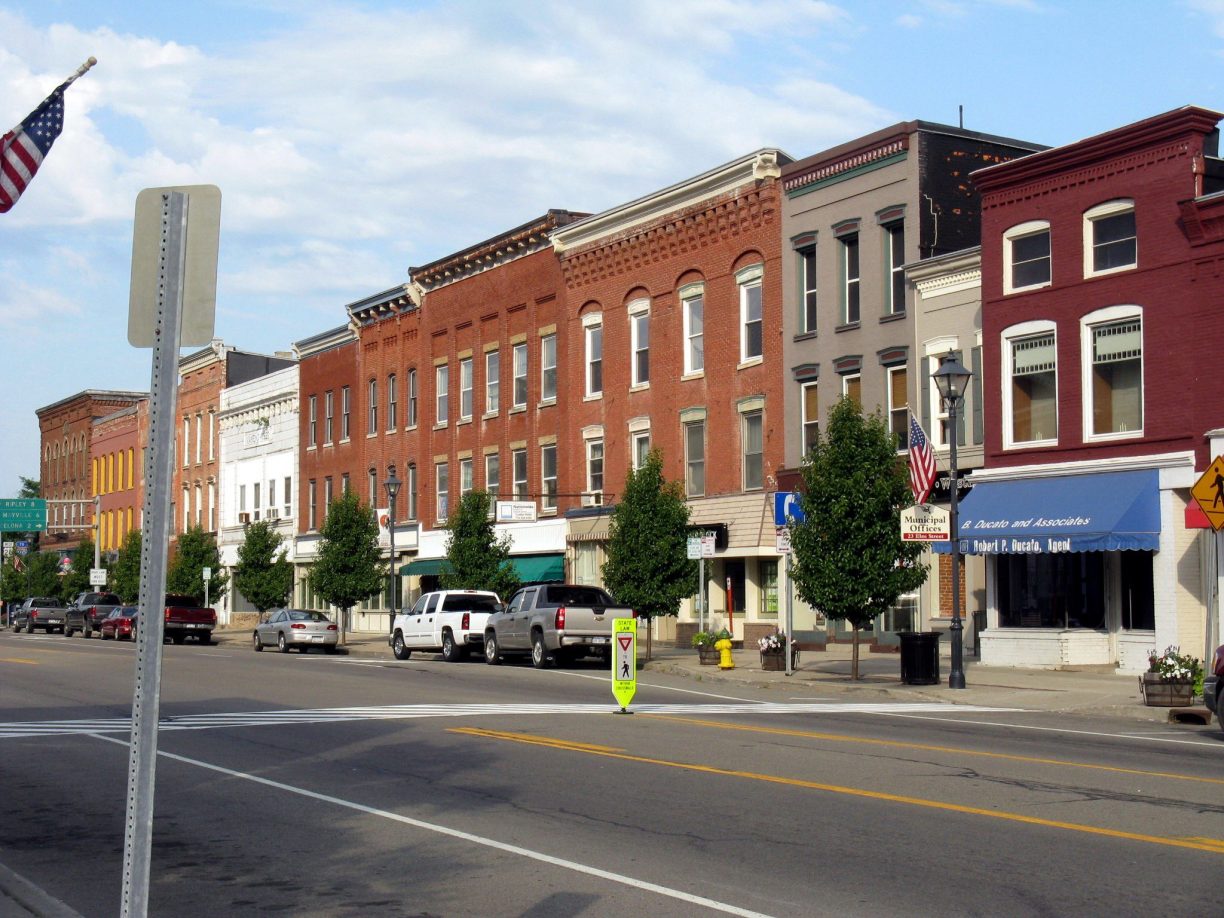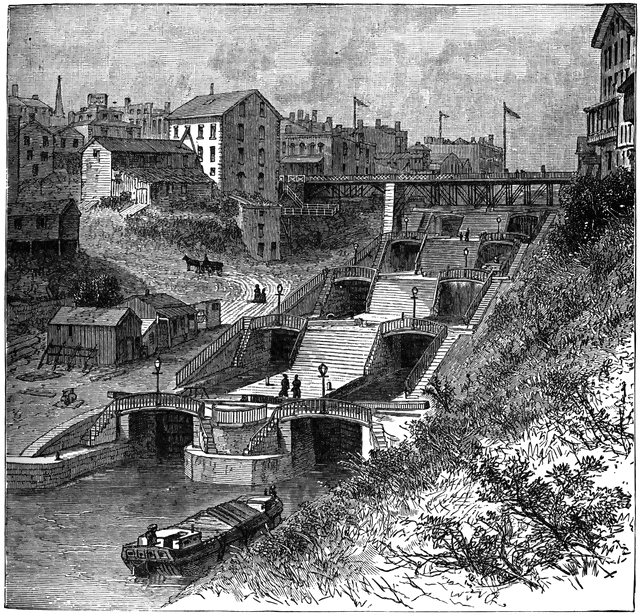
The State of New York State History
On April 12, 2015, Representative Paul Tonko received the Legislative Leadership Award from the Museum Association of New York (MANY). He was a co-winner with Senator Kirsten Gillibrand of the inaugural award by MANY. The award recognizes exemplary leadership in support of museums and cultural institutions in the state. These two elected officials were cited for their work in Congress in support of funding the Office of Museum Services within the Institute of Museum and Library Services (IMLS).
Representative Tonko appeared in person in Corning to receive the award at the annual MANY conference. During the reception in the glass-blowing exhibit area, he spoke to the attendees. Unfortunately, I took no notes and did not record what he said. In general terms, I was impressed with what he had to say, with his vocabulary and choice of words on behalf of local and state history. As I recall, he never once mentioned them in conjunction with economic development or job creation. It was all about the civic and social importance of local history in the community.
On April 2, 2017, Representative Tonko was present in Saratoga Springs at the MANY conference when Regent Roger Tilles was the award winner. As a member of the Culture sub-committee, Tilles deals directly with the state Archives, Library, and Museum. He received the award due to work in support of the Museum Education Act. During the reception, Tonko addressed the audience. This time I paid more attention to his words. At times he seemed to be channeling my blog. I do not know him and I doubt he has read them, nonetheless one couldn’t help but wish when it comes to local and state history that he was governor. He is well aware of the of the importance of a sense of place, a sense of belonging, a sense of community and the importance of local history to the social fabric and civic health of a municipality. Once again, there was no mention of economic development or job creation as primary responsibilities of local and state history organizations.
It is hard to imagine Governor Cuomo ever winning the MANY Legislative Leadership award unless it was a crass political move as a quid pro quo in his quest to be President. Let’s look at some of the key actions which have occurred during his tenure.
1. Member items have been eliminated. Given the chronic corruption in the state government, one might easily applaud this attempt to rein in the endemic misuse and abuse of taxpayer money. Unfortunately, the action threw out the baby with the bathwater. Many small non-profits seeking comparatively small sums of funding turned to their local legislator and/or senator (as I did) for support. Larger scale funding often was a bureaucratic challenge. Starlyn D’Angelo, executive director Albany Shaker Heritage Society and current MANY Board of Director, raised this very point at the History Roundtable chaired by State Legislator Steve Englebright on May 29, 2014 with Regent Tilles in attendance (see Report from the NYS History Commission Roundtable). It was Devin Lander’s last day as a legislative aide before becoming executive director of MANY, his position before becoming State Historian. While there is some funding in Republican Senate districts as Fort Niagara availed itself of, there is no state-wide mechanism to address the small-scale needs of the history community (see January History News).
2. REDC funding has now begun a new cycle of funding application for the 2017 awards. To some extent, the funding simply includes the types of funding that history organizations directly applied to NYSOPRHP and NYSAC for in the past. In general terms the local history organization has no place in this process. The Regional Economic Development Councils (REDC) are interested in economic development and job development. Imagine if the local library had to request funding based on those standards…or the police department!
The game is rigged against the history community. At the recent MANY conference, Ross Levi, Marketing Initiatives for Empire State Development for I Love New York and the public face of the Path through History, spoke in the “Partnerships for Progress: Museums and Tourism” session. The theme of the session was the ways in which museums and cultural institutions can partner with I Love New York to promote their organizations. I will more to say about this in future posts taking into account the Tourism Advocacy Council, the plenary address at MANY, and related materials.
In the meantime, I wish to report on a question asked from the audience to Ross about the local tourism representation. At the second Women’s Suffrage conference last October 7, (see Women’s Suffrage Centennial), Rick Newman, Seneca County TPA, distributed a list of the Tourism Promotion Agency (TPA) from every county. By law, I Love New York works through these agencies and not directly with local history organizations. Ross suggested that the local history organizations contact the TPA in their county. These TPAs could be an advocate for the history community in the REDC funding process.
I take Ross at his word. While I do not know him well, I think he genuinely believed what he was saying was sound advice with real world application. Here we have a classic example of the disconnect between the Albany-Manhattan bubble and that real world. While I can only comment anecdotally, I have heard multiple incidents from people in the history community about TPAs who don’t give them the time of day. TPAs are interested in wineries, recreational tourism, and sites that bring head to beds. TPAs often are non-government organizations, that is, chambers of commerce, working to do what is best for its members. The members rarely are small non-profit history organizations and are even if they were or became members, they are not likely to carry much weight. There is nothing wrong with Chambers of Commerce actively promoting economic development, but once again it means the history community is left high and dry with nowhere to turn in the funding process.
3. Speaking of nowhere to turn, let’s turn to the great failure itself, the Path through History. It will celebrate its fifth anniversary on August 28, 2017. What does it have to show for itself? I attended the kickoff meeting for the HV region on January 25, 2013 (see A Fork in the Road on the Path through History). Of the ten regions originally created and recipients of $100,000 grants from the State, how many of those regions are still functioning? If they are functioning, what do they do? If they aren’t functioning, what replaced them? Was there ever any additional funding?
Historic sites are ranked by revenue/budget for tourist purposes. Within the Hudson Valley region where I live, there are five over the $1,000,000 threshold I Love New York uses to calculate the crown jewels for tourism. I don’t know what they are in this region but some possibilities include Historic Hudson Valley (multiple sites including Kykuit), Franklin and Eleanor Roosevelt library and homes run by the National Park Service and National Archives, and the Culinary Institute. Approximately 70% of the organizations in the region are under $50,000 in revenue meaning they are below the radar where anyone in the state gives a dam about them.
In my blog after the initial meeting, I recommended that the $100,000 be used to hire people who would create paths. Years later, I recommended that there be funding through the REDC process to hire PATHFINDERS who would create the paths that the TPAs and I Love New York would promote (see Create Pathfinders in Your Region). One region tried and it was rejected – there is no place for cooperation and collaboration no matter what jargon terms are used at conferences and meetings. Once again the history community is left high and dry.
As it turns out there are people at the grassroots level who can and have created paths through history. Generally these are conjunction with a conference. I will be writing about these examples in a future post. Of course, these are created without state support or promotion.
The cost to New York State of the failure to respect the Tonko model is enormous if difficult to quantify. The stakes for the country are even larger. It goes to the heart of what it means to be an American and resident of one’s community. In a recent op-ed piece entitled “America’s Political Disunion” by Robert P. Jones (NYT 5/2/17), he cited British writer G. K. Chesterton’s observation after he had visited the United States that unlike European countries we did not rely on ethnic kinship or cultural character to create a shared identity. People of any race, any ethnicity, any religion can and have been American. Once upon a time in New York, German Palatines, the English, the Dutch, the French both Huguenots and Catholics, Scotch-Irish Protestants and Irish Catholics, were people of different “nations” and types. Today they are all Americans and lumped together as white. And anyone who thinks all the Haudenosaunee nations live together in a two-dimensional kumbaya relationship as one Native American people should think again or think for the first time.
We are a storytelling species. We’ve lost that story feeling. We’ve lost the narrative. Can we tell a shared story of our history at the national level, at the state level, at the community level? Can we tell a narrative that unites us around a common multigenerational project that gives an overarching sense of meaning and purpose to our history? What is our shared narrative in our community? What is our shared narrative in our state? What is our shared narrative as Americans?
For most of the past 400 years, America did have an overarching story. It was the Exodus story.
The Puritans came to this continent and felt they were escaping the bondage of Egypt and building a new Jerusalem….
During the revolution, the founding fathers had that fierce urgency too and drew just as heavily on the Exodus story….
Frederick Douglas embraced the Exodus too….
The successive immigrant groups saw themselves performing an exodus to a promised land…
In the 20th century, Martin Luther King Jr. and other civil rights leaders drew on the Exodus more than any other story (David Brooks, “The Unifying American Story, NYT 3/21/17).
There is a unity in the story from long ago in lands far far away to boldly going where no one has gone before. There are stories to be told in every community throughout the land from Ice Age to Global Warming about the people who lived there and the people who do live there. There are stories to be told about how all the different peoples of the Mohawk Valley became part of We the People. There are stories to be told about how all the peoples who arrived at Castle Garden became part of We the People. There are stories to be told about how all the peoples who arrived at Ellis Island became part of We the People. There are stories to be told about how all the people who arrived at JFK Airport became part of We the People.
There are stories to be told if We the People are to survive as a nation, to long endure, to not become Syria, to not become Yugoslavia, to not become Iraq. We don’t even celebrate the birthday of our state or the anniversary of when we constituted ourselves as New Yorkers.
Brooks ends his op-ed piece with a call to leadership for We the People.
What’s needed is an act of imagination, someone who can tell us what our goal is, and offer an ideal vision of what the country and the world should be.
Neither of the candidates provided such a vision in 2016. They didn’t even try. Will anything be different in the 2020 rematch? Maybe Tonko should run for president instead of Cuomo.














